By Jan Worth-Nelson
An 80-acre park in Flint which had been overrun by neglect, arson and invasive species is getting a big dose of love and hoped-for restoration from a partnership between the College Cultural Neighborhood Association (CCNA), the Genesee Conservation District (GCD) and the City of Flint.
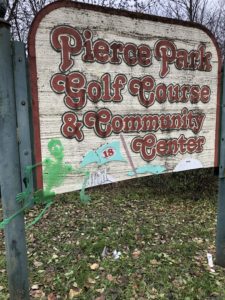
Entrance to the park at Gilkey Creek (Vernon and Brookside). Green skeleton left from Halloween “decorations.” (Photo by Jan Worth-Nelson)
Pierce Park, owned by the city since the early 1960s, lies between 1-69, Dort Highway, Gilkey Creek, and a residential swathe on the south side of the College Cultural Neighborhood.
According to a detailed five-year strategic plan produced by the collaborative team, three primary areas of focus for the project are habitats restoration, a one-and-a-half-acre dog park, and creation of an energy efficient building that could be used by the CCNA, the GCD, and other community partners.
That would mean removing invasive species, expanding and maintaining walking and jogging trails, and, as the plan states, implementing “conservation practices to improve ecological health of the park’s natural assets: forest, meadow and creek.”
Named after the family that donated the land to the city, Pierce Park originally was an 18-hole public golf course which opened in 1964. It was designed by Arnold Trusdale and included a clubhouse. For a time, there was a golf pro on staff. A lawn bowling course adjoined the clubhouse and there were several tennis courts on the west side of the parking lot.
According to Gary Fisher from the Genesee County Historical Society, John Pierce was one of the developers of the Capitol Theater. He was a real estate mogul of the time who developed the College/Cultural neighborhood south of Court as well as Woodcroft Estates south of Miller Road.
Pierce Street and Pierce Elementary also were named for the family.
The park land has experienced hard times. Facing financial stresses, the city closed the golf course in 2011 and the property has sat mostly untended for ten years, the clubhouse gradually deteriorating and covered with graffiti. A series of proposals for the building emerged but nothing ever came of them.
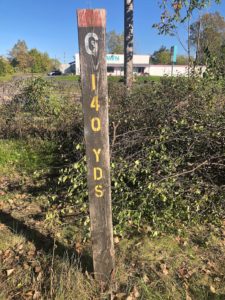
Evidence of the golf course: The Sixth Hole marker
Then in September 2020, arsonists torched the building, burning it to the ground. The scorched ruins remained fenced and untouched for eight months during the pandemic; finally demolition brought down the building’s remaining structure, including its distinctive stone pillars. On thistle-choked hillocks, several hole markers poke up from the weeds, and golf balls can still be found in the turf and saddles of downed trees.

Charred remains of the clubhouse at Pierce Park (Photo from September 2020) sat untouched for eight months before being removed. (Photo by Jan Worth-Nelson)
CCNA president Mike Keeler, a retired GM shopworker, UAW activist, and avid horticulturalist, had long recognized the park’s surviving assets, and saw opportunity in the overgrown parcel left behind.
So Keeler and his wife Sherry Hayden, the CCNA vice president, approached Angela Warren, administrator of the Conservation District, and she agreed the possibilities were promising. Together, along with a steering committee of CCNA residents and GCD staff, they worked out the five-year plan which kicked off in 2021-22 to transform the park, along with the sections of Gilkey Creek that wind around it, into a nature preserve that would restore the native ecosystem and open up the space to the community for recreation and education.
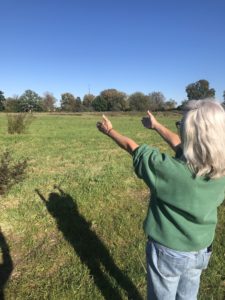
GCD Administrator Angela Warren surveying Pierce Park. (Photo by Jan Worth-Nelson)
The GCD, which will be the fiduciary for the park project, is an entity of state government — one of 75 such conservation districts in the state.
The project has so far been so positive in its early stages that if it works over time, its partners say they hope it might provide a template for similar projects in city parks that could be used by others.
The formal mission statement for the five-year plan is “to improve the ecological health, education and recreation opportunities for the community through responsible planning and natural resource management of Pierce Park.”
Many factors still need to come together to realize that mission for the park – funding being one essential, since all the mowing and other work so far have been covered out of the personal pockets of volunteers – but all those involved communicate delight at both the possibilities of the park and the pleasures of the collaborative effort.
But in the meantime, Keeler has nightmares about buckthorn bushes, not to mention Canadian thistles.
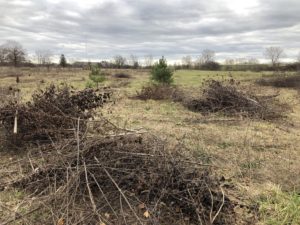
Piles of buckthorn. (Photo by Jan Worth-Nelson)
Those two invasive species are among the tough, resistant challenges facing the Pierce Park group.
In the years after the golf course closed, with only intermittent mowing, the original turf grew unimpeded into a thick carpet. The buckthorn, originally planted as landscaping around the perimeters of the course, spread by birds eating and dropping its berries, and overtook wide sections of the core of the property.
Energetic volunteers have been chopping away at the buckthorn, putting it into heaps and trying to figure out how to dispose of it. Keeler and CCN neighbor Larry Anderson have spent many days on the project, using bush hog cutters borrowed from Herb Pitts’ tool shed at the Neighborhood Engagement Hub.
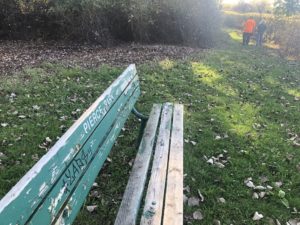
A beat-up bench on the south side of the park.
As some of the thick buckthorn was cleared, other species became visible, to the delight of Keeler and Angela Warren, taking stock of the property in an October tour of the site with EVM.
“My jaw dropped when I saw the beautiful trees we had on the property,” Warren said.
There is a grove of walnut trees near Dort Highway; an immense chinkapin oak that takes three people to encircle it; there are numerous Austrian pines, white oaks, a bitternut hickory, a shagbark hickory, American lindens, a sycamore, a sugar maple.
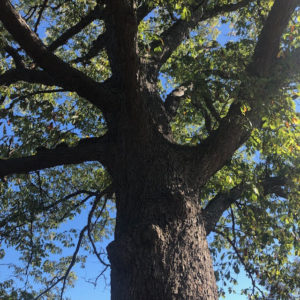
Chinkapin Oak on the south side of the Park. (Photo by Jan Worth-Nelson)
Additionally, as Mother Nature gradually reclaimed the land, wildlife has flourished, including deer, foxes, at least one coyote, rabbits, voles, hawks, screech owls, a multitude of other birds, and monarch butterflies, in the small patches of milkweed the buckthorn didn’t take over.
A significant step forward for the park team came with an August letter of agreement from the city’s Department of Planning and Development.
It authorizes the two partners – the CCNA and the GCD – to embark on their proposed series of ecological activities, including surveying and mapping the parcel; removing invasive species; planting trees, native meadow and other plants; engaging with the community through meetings, surveys and other activities; and to continue to design, plan, and develop their five-year plan.
While all the funds to support the work haven’t been secured – requests are pending – some work in the first year has been accomplished. A pavilion remaining on the property got a new $9,000 roof from a Habitat Flint BRAND grant, fencing is set to be installed pending grant support, species inventories are underway, and a design for a pollinator meadow is in the works.
And there is a 150-square-foot garden, originally called the Sanctuary Art Park, remaining that has been in process for several years which CCN resident and steering committee member Rebecca Pettengill hopes to continue developing.
In the letter of agreement, Suzanne Wilcox, director of the Department of Planning and Development, said her department is “especially interested in the success and collaborative nature of this work,” and indicated the city additionally would be interested in outreach activities and assisting in any other capacity that’s needed.
Even during the years of neglect, the acreage has attracted its neighbors. A trail around the perimeter has been regularly mowed by volunteers, and anybody walking through the park from Cadet on the east side to Brookside and Vernon on the north by Gilkey Creek is bound to see other neighbors, many with their dogs.
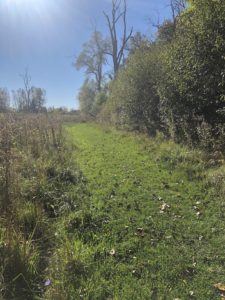
The walking trail on the north side of the park along Gilkey Creek.
The steering committee for the project includes Warren, Keeler, Hayden, along with Micah Hutchison, a CCNA resident, GCD staff member, and a master gardener. Also in the group are Realtor Mark Fisher, and representing the City, Roy Lash, Parks and Recreation Director.
Additional volunteers include Robert Miner, Danielle Neiswender, Larry Anderson, Becky Pettengill, and Herb Pitts from the Neighborhood Engagement Hub tool shed.
The park team will be looking for additional support from the community in the coming months into next spring, Keeler said. There is more brush to clear, trees to plant, and donations sought to pay for mowing.
One neighbor who’s got a long and affectionate connection to the land is Don Potter, 71, who grew up on Hills Street. He remembers a time when the woods that became Pierce Park were a wild place to explore, build forts, sneak cigarettes, and hunt pheasants and rabbits with his bow and arrow.
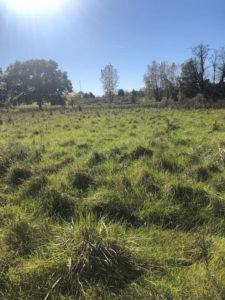
Thick turf overgrown from the former greens covers much of the central section.
“It was great,” recalls Potter, who now lives on Blanchard just a few blocks from his childhood home. “It was wild – it was our own private woods.”
In the early 60s, of course, that changed when the golf course came in.
The kids were against it, recalled Potter, who recently retired from the music promotion company Wolverine Productions. He’s got deep roots in the neighborhood. His father James owned Potter and Gage Insurance and was on the parks board back in the day — and his grandfather Ernest was president of Citizens Bank.
And Potter hopes the park gets a new lease on life. “It sounds great,” he said when considering the five-year plan.
“If we can pull this off, it might be a blueprint of how other parks can work with neighborhoods to do something similar,” Keeler said.
In the meantime, Potter might just get a little of that wild space back.
EVM consulting editor Jan Worth-Nelson can be reached at janworth1118@gmail.com.


You must be logged in to post a comment.